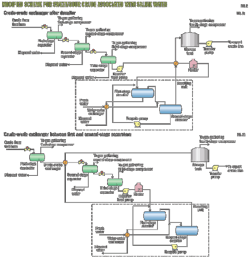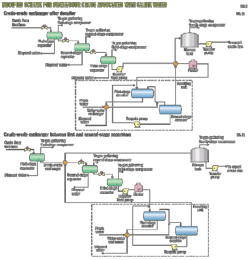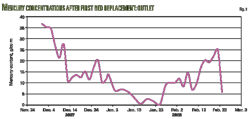Alex Aynbinder
Cronus Technology Inc.
Houston
David Bevil
WorleyParsons Group
Houston
A new methodology assesses the risk of upheaval buckling and determines the required profile of the trench bottom as a bed for both subsea and onshore pipelines.
The method uses as input data the design operating parameters of the pipeline (internal pressure and temperature differential) and soil properties. Variable parameters are depth of cover, thickness of concrete coating or concrete weight for overbend pipeline section, if required, and angle of turn and minimum elastic (free) bend radius, or the height of any hills to be crossed.
Background
When a pipeline is operated at a temperature higher than tie-in and high internal pressure, the high temperature-high pressure (HT/HP) pipeline will try to expand. If the line is not free to expand, an axial compressive force develops in the pipe, potentially causing considerable vertical, lateral, or combined movement.
When the line is buried in a trench, the lateral soil resistance usually exceeds both the vertical uplift resistance created by the pipe's air or submerged weight and the soil overburden, in which case the pipe will tend to move upward, and unacceptable large vertical movement (displacements) may occur partly to release the compressive force. This phenomenon is called upheaval or global buckling.
The primary factors affecting the buckling behavior of buried pipeline include the compressive axial force due to temperature differential and internal pressure, soil resistance, and pipeline geometry (profile). The stability of the pipeline in its initial position turns out to depend on the local profile of the pipe in contact with its foundation (bottom of the trench) and on whether enough downward force is present to hold the pipe in the position.
Methodology
The methodology presented here is based on the beam-column theory and the rigid-plastic soil model (soil restriction does not depend on movement). It uses the industry-recognized Palmer's method1 2 in that the total downward load is the load required to maintain the pipeline in the imperfect position.
The analysis presented in this article differs from the analysis in Palmer's paper in that the initial so-called imperfection profile is described as elastic (free), with bending parameters (radius and angle of turn) or the size of short slip hill (maximum imperfection and stress criteria-minimum radius) established in their design. Pipeline design typically determines the allowable minimum bending radius based on combined stresses due to maximum operating conditions. The upheaval buckling analysis may require increasing the value of minimum bending radius.
This article seeks to develop a methodology of risk assessment of the upheaval buckling for buried subsea pipelines. The assessment proceeds in four steps:
• Calculation of effective axial force due to temperature and pressure differentials.
• Determination of the downward force required to lay the pipeline in design position at installation conditions.
• Determination of required downward load at operating conditions to stabilize fixed profile.
• Risk assessment of designed upheaval buckling pipeline parameters.
Effective axial force
The internal pressures and force caused by the temperature differential in the pipe wall (true force) determine the effective axial force. The effective compressive axial force over the entire cross-section of the pipe consists of the sum of two components: the axial force in the cross-section of pipe, internal pressure times the internal area of pipe cross section, and the axial force in the wall pipe, N, axial stress times the steel cross-sectional area (Equation 1). In a fully restrained pipeline, Equation 2 calculates the tensile axial force (true force) due to internal pressure and the positive temperature differential (the difference between operating and installation temperature).
Downward load
• Elastic (free) bending. Trenching and laying operations modify the profile of the bottom of the trench (foundation) on which the pipe rests. The bottom of the trench should support the pipeline. Elastic bending usually provides changes of the pipeline profile in the vertical plane. Elastic bending of the pipeline in the vertical plane stems from the transverse load q, which is part or full linear weight of pipe, and the restriction of the trench profile. The solution of the condition of equilibrium (Equation 3) and boundary conditions (Equation 4) therefore determines the pipeline and design bottom of trench profiles.
From the solution of the differential equation (Equation 3) with consideration boundary conditions (Equation 4), Equation 5 represents pipeline profile and the distance to connection with straight pipe.
In design practice, minimum allowable bending radius, Rmin, in addition to the angle of turn, describes the requirements for elastic bending.
The condition of Equation 6 yields:
• The relation between required transverse load and minimum elastic bend radius and angle of turn (Equation 7).
• The relation between distance and minimum elastic bend radius and angle of turn (Equation 8).
• Pipeline and bottom trench profiles (Equation 9).
The pipeline profile is a parabola with variable radius from infinite at the connection with straight pipe and a given minimum radius on the hill. The tangent of this curve is 1.5 times more than the tangent of a circle curve.
Equation 7 is the main equation, describing the relation between minimum elastic bend radius, angle of turn, pipe flexural rigidity, and required weight for the pipeline profile to be in continuous contact with trench bottom. The maximum value of load q is the linear weight of the pipe if the pipe is installed in the trench without water or the submerged weight of pipe during installation. Stress criteria determine the allowable minimum elastic bending radius Rmin. If the required load is more than the maximum weight of pipe, minimum radius or angle of turn must be increased.
• Profile changing due to short steep-sided hills. Short steep-sided hills as part of the profile introduce a complication in that the pipeline may form spans on either side. Examples of such local imperfections include the crossing of foreign pipelines, cables, etc.
Height describes this parameter and is established at design. Analysis of the beam under downward loads determines the length of each side span. The design profile should also comply with stress criteria. As for the previous case, the minimum radius along the section will establish these criteria.
Under an assumption that the beginning of a coordinate axis is on the summit of the curve, the unknown lengths of the spans are l = L/2, and height is denoted by fo. Equation 10 describes boundary conditions in this case.
Solving the differential equation (Equation 3) with consideration of boundary conditions (Equation 10) yields the pipeline profile and the distance to the connection with straight pipe (Equation 11).
The curvature describes allowable bending stress, and Equation 12 describes the minimum radius.
Using Equation 12:
• Equation 13 presents the relation between required transverse load and minimum elastic bend radius and initial displacement.
• Equation 14 presents the relation between distance and minimum elastic bend radius and initial displacement.
Equation 13 is the main equation describing the relation between minimum elastic bend radius, initial displacement, pipe flexural rigidity, and required weight for the trench and pipeline profile (Equation 11) to be in continuous contact.
Fixed-profile stabilization
Classic beam-column theory for a pipeline under the axial compressive force S and downward load/unit length w(x) yields an equilibrium condition described by Equation 15.
Load w(x) represents the downward load required to maintain the pipeline in position v(x) described as initially imperfect due to the elastic bending or the short, steep hills. Equation 2 determines the value of axial compressive force S, with initial profiles described by Equation 9 or 11 for elastic bending and hills, respectively.
• Elastic (free) bending. Substituting profile Equation 9 in the condition of equilibrium, Equation 15, yields the distribution of the required loads along the section of elastic bend (Equation 16).
The largest required load wmax occurs on the summit of the hill, when x = 0. Equation 17 calculates its value. Equation 18 determines the critical length that required maximum load. From this condition, Equation 19 calculates the critical length.
Substituting the critical length in Equation 17 causes critical load to be calculated by Equation 20.
• Short, steep hills. Substituting the profile Equation 11 in Equation 15 allows distribution of the required loads along the section of pipeline at a steep-sided hill to be found in Equation 21.
The largest required force wmax occurs on the summit of the hill, when x = 0. Equation 22 calculates its value. Equation 23 determines the critical length that required maximum load. From this condition, Equation 24 calculates the critical length. Substituting the critical length in Equation 22 causes critical load to be calculated by Equation 25.
Risk assessment
Equations 7 and 13 therefore calculate required vertical loads for a pipeline to be laid in the design profile for elastic (free) bending and in the design profile for short steep-sided hills, respectively. Equations 20 and 25 calculate, respectively, the required vertical loads for pipeline stabilization due to internal pressure and temperature differential for a pipeline to be laid in the design profile for elastic (free) bending and in the design profile for short steep-sided hills.
Risk assessment of upheaval buckling may be guided by comparing the required total load presented by Equation 26 as the sum of the required loads to lay the pipe in the design position (profile) and to stabilize the pipe during operation (temperature and internal pressure effect) with the total loads calculated by Equation 27 as sum of the load by the weight of pipe (Equation 28) and uplift soil resistance calculated by Equation 29.
DNV-RP-F110-2007 states the approach should "design a sufficient cover height to prevent upheaval buckling and keep the pipe in its original position." Equation 30 can calculate the safety factor, or design criteria for upheaval buckling failure mode. Establishing the value of the safety factor as criteria at 1.1 yields a conservative approach in determining stabilization loads.
Design approach
The presented example (see table) includes the nomenclature used in the equations box and describes the process of upheaval buckling risk assessment.
The stress criteria and the load required for installation should establish minimum bending radius and angle of turn or hill deflection. The load of the pipe during installation should consider submerged weight of bare pipe and concrete coating. The uplift soil resistance should consider the possible soil properties during operation.
References
1. Palmer, A.C., Ellinas, C.P., Richards, D.M., and Guijt, J., "Design of Submarine Pipelines Against Upheaval Buckling," Offshore Technology Conference, Houston, May 7-10, 1990.
2. DNV-RP-F110-2007, "Global Buckling of Submarine Pipelines," Det Norske Veritas, 2007.
The authors
More Oil & Gas Journal Current Issue Articles
More Oil & Gas Journal Archives Issue Articles
View Oil and Gas Articles on PennEnergy.com





